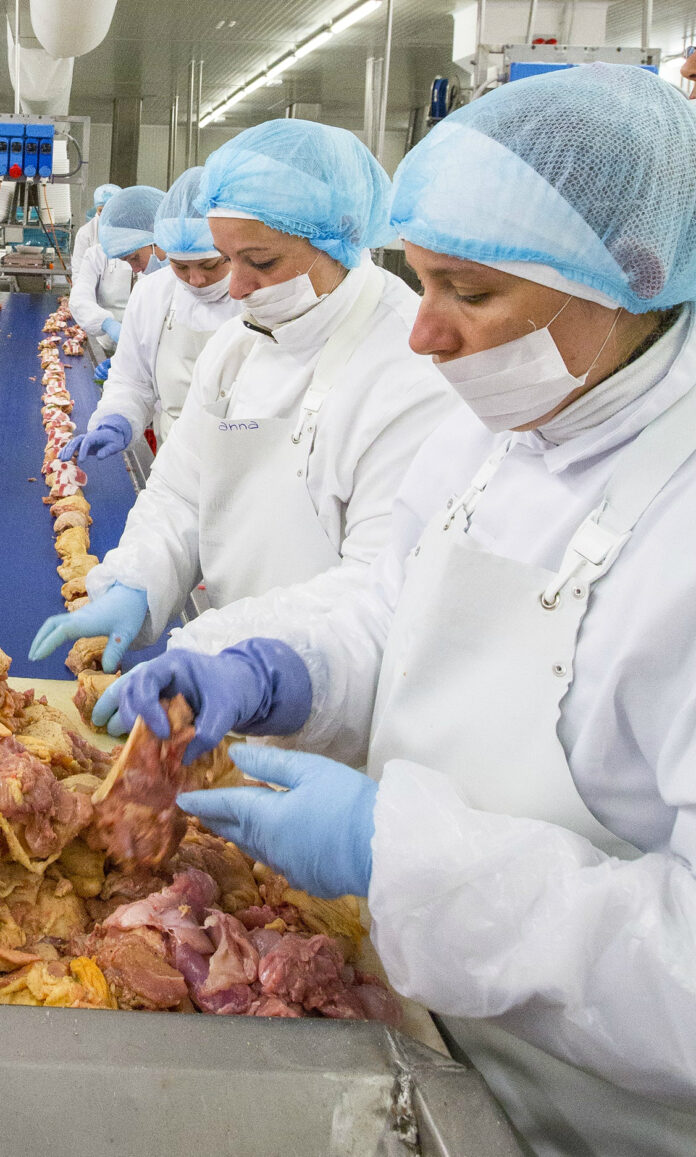
No matter the degree of automation of any given poultry processing plant! There will always be a need for laborers, yet just a few ones, somewhere along the line. Therefore, the consideration for the work ergonomics becomes imperative as to guarantee the workers’ physical integrity and health.
Eng. Fabio G. Nunes – Poultry Processing Consultant, Brazil
In management, the first concern of the company is the happiness of people connected with it. If the people do not feel happy and cannot be made happy, that company does not deserve to exist.
Kaoru Ishikawa, July 13, 1915 – April 16, 1989
What is ergonomics and why is it important in a poultry processing plant? Ergonomics is the science of adapting workplace conditions to fit the worker’s body as to reduce the stress associated with the overuse of muscles, bad posture and repeated tasks, therefore eliminating many potentially serious, disabling work-related musculoskeletal disorders (MSDs).
MSDs are injuries that can affect nearly all body’s soft tissues and nervous system, as well. These painful and often disabling injuries generally develop gradually over time and most frequently effects arms and back. MSDs affect over 1.7 billion people worldwide and have the fourth greatest impact on the overall health of the world population, considering both death and disability.
The work ergonomics acquires great importance within the global poultry industry as it is a very labor-intensive business, which demand a large array of manually performed tasks requiring different intensity of struggle and is characterizes by high production rates.
Therefore, industry jobs involve one or more of the following circumstances: working more than 8 hours a day; increasing specialization leading workers to perform only one function or movement for a long period of time or day after day; quick working pace at killing or deboning line, for example, and having tighter grips when performing cutting and boning tasks. According to USA’s OSHA – Organizational Safety and Health Agency, these factors, especially if coupled with poor machine, workplace and tool design create physical stress on workers’ bodies that can lead to MSDs.
Workplace hazards
Workplace hazards that most contribute to ergonomic injuries include awkward postures, repetition, material handling, force, mechanical compression, vibration, temperature extremes, glare, inadequate lighting, and duration of exposure. The article will address just four of them.
Repetition
In a poultry plant nearly all tasks are very repetitive with overall cadence driven by the killing line speed. Good examples are live hanging, edible giblets collection, re-hanging out of chiller, insertion of giblets package into whole carcasses cavity and the many hand cutting and deboning operations.
Extended reaching
Tasks that demand elevated and long reaches stress shoulders, elbows and back, and can produce ergonomic injuries. A few good examples of extended reaching in the plant are: hanging live birds or carcasses onto an elevated shackle line at reception out of chiller and onto the cutup line; manual inspection of inside the carcasses hanging on elevated conveyors; stacking and de-stacking live broilers crates at farm and plant; piling products boxes onto trucks for shipment, and collecting products from a conveyor that is too wide are.
Heavy lifting
At farm, live catching by the legs demand each worker lifts 3 or even 4 birds of 2.5 kg per hand at a time with tenths of repetitions per hour. Stacking of crates with live chickens onto trucks require the lifting of units weighing 25 kg or more above the head tenths of time per hour, as well. At plant, when crates unloading is manual, workers must pull 9 crates-high stacks out of the truck, drag them to the hanging station and de-stacking them manually for hanging; workers commonly hang in between 800 and 1,000 bph requiring a range of 13 and 17 movements per minute to lift from 1,600 kg to 2,500 kg per hour. In-plant logistics usually requires moving heavy totes, piles of boxes and heavy cart around manually, and workers must manually load packed boxes of product onto pallets and move loaded pallets.
Awkward posture
Awkward postures are deviations of body parts from their natural position. Working in these postures contributes to MSDs development. Working with wrists in a bent rather than straight position, and especially where the task also involves high hand force, can result in ergonomic injuries over time.
Examples of wrist awkward positions are found in the inspection of body cavities to remove missed material; in the use of in-line knives which often forces employees to bend their wrists to exert the finger and hand force necessary to hold and control the knife, and boning tasks that force employees to bend their wrists 30-40 degrees, especially when working on a horizontal surface.
Poultry companies must place ergonomics as a top priority and consider implementing programs to overcome or mitigate the risks to workers’ health associated with the work hazards. OSHA suggests such a program must contain three primary sections – (I) a discussion of the importance of management commitment and employee involvement, (II) recommended program elements and (III) essential, detailed guidance and examples for the program elements – and embrace five elements:
1) Plant floor analysis: aims at identifying existing conditions, operations and work methods that create hazards, and areas where hazards may develop over time;
2) Hazard prevention and control: Once ergonomic hazards are identified, the next step is to design a set of single or multiple measures to prevent or control them;
3) Medical management: it is necessary to eliminate and materially reduce the risk of development of illnesses signs and symptoms through early identification and treatment, and to prevent future problems through development of information sources.
4) Training and education: aims at ensuring that employees are sufficiently informed about the ergonomic hazards to which they may be exposed to and thus are able to participate actively in their own protection.
5) Outcome evaluation: procedures for evaluation of the ergonomics process and to monitor progresses are central to continuous improvement and long-term success of the program.
The rewards from the implementation of an effective ergonomics program throughout the plant are improved worker safety, comfort and morale. A clear proof that prevention pays off!
Literature available from author upon request
















